Case Study: Contract Formation and Breach Between Ben and Fiona
VerifiedAdded on 2020/04/07
|7
|1657
|39
Case Study
AI Summary
This case study examines the formation and potential breach of contract between Ben and Fiona regarding the sale of Ben's cafe, La Mint. The analysis delves into the legal principles of offer, acceptance, and consideration, essential elements for a valid contract. It explores the initial advertisement as an invitation to treat, Fiona's offer to purchase the cafe, and Ben's subsequent acceptance via email. The case highlights the importance of clear communication and the timing of acceptance and revocation. The study also touches upon the concept of a counteroffer and the ability to withdraw an offer before acceptance. The conclusion determines whether a legally enforceable contract was created between Ben and Fiona, leading to potential remedies for breach of contract.
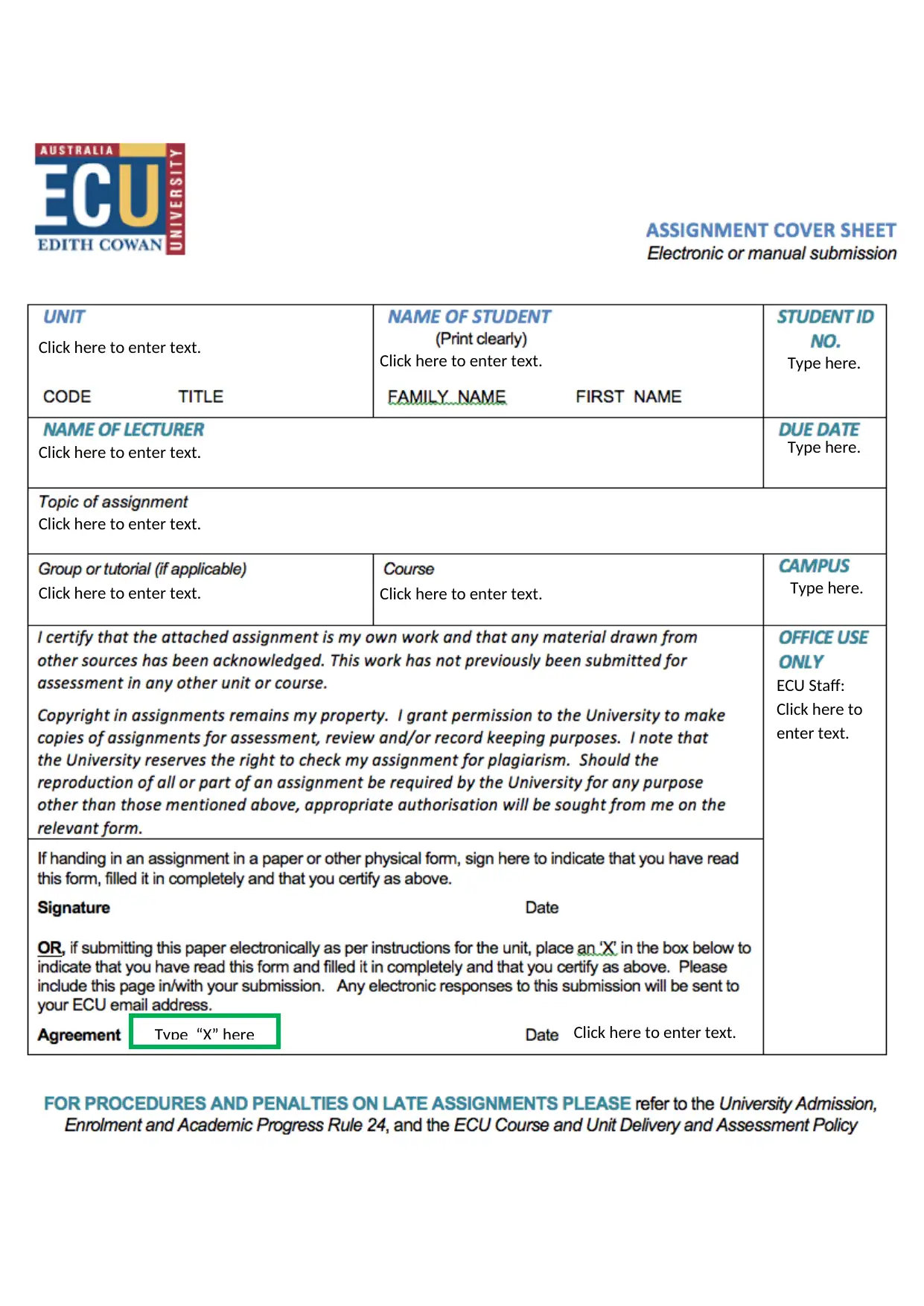
Click here to enter text. Click here to enter text.
Click here to enter text.
Click here to enter text.
Click here to enter text. Click here to enter text.
Type “X” here Click here to enter text.
ECU Staff:
Click here to
enter text.
Type here.
Type here.
Type here.
Click here to enter text.
Click here to enter text.
Click here to enter text. Click here to enter text.
Type “X” here Click here to enter text.
ECU Staff:
Click here to
enter text.
Type here.
Type here.
Type here.
Paraphrase This Document
Need a fresh take? Get an instant paraphrase of this document with our AI Paraphraser

Students, please be aware that this section is for lecturers to fill out after assignment submission. It is a side-measure
intended to measure writing and literacy, and is not part of your official assessment…
intended to measure writing and literacy, and is not part of your official assessment…
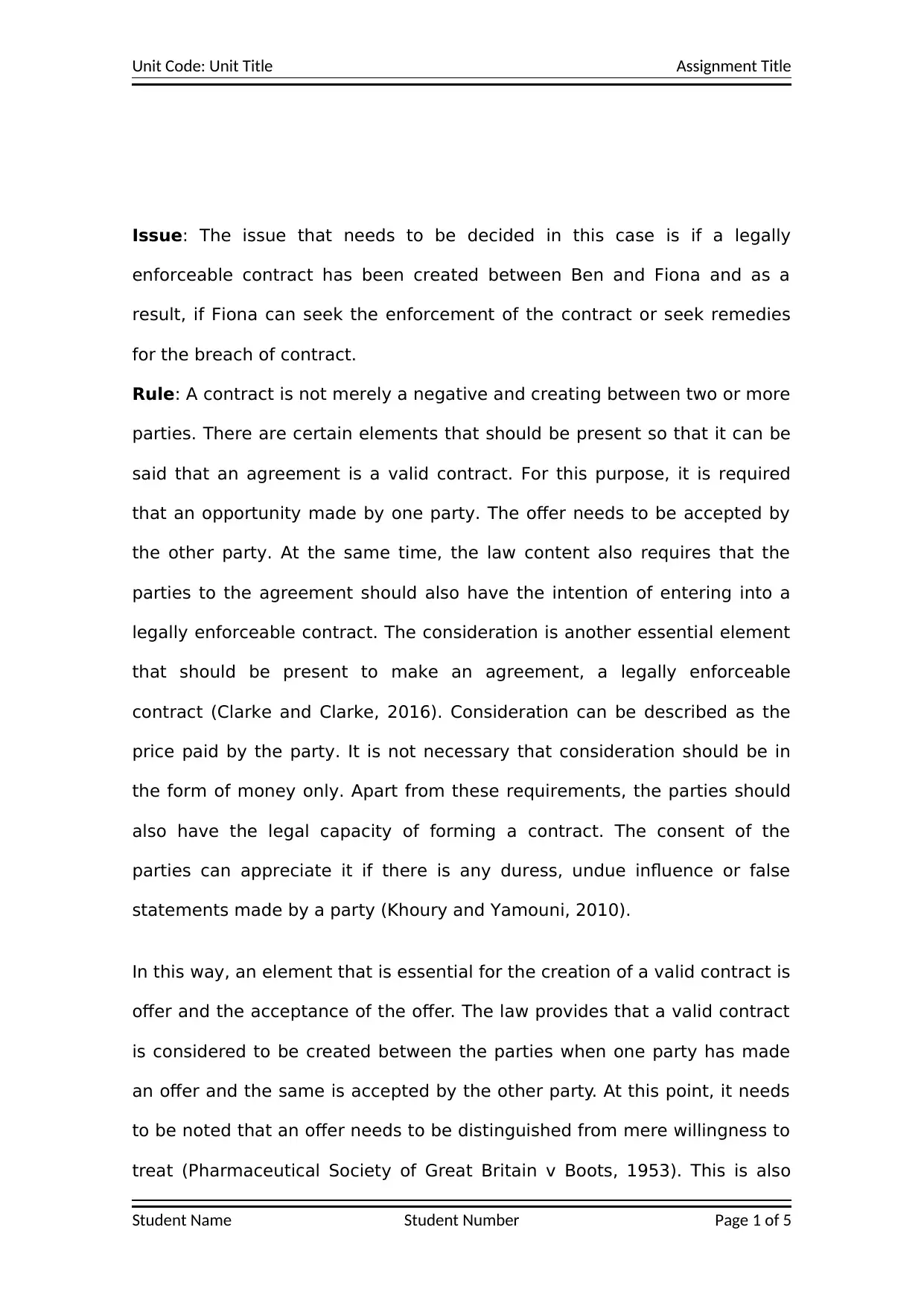
Unit Code: Unit Title Assignment Title
Issue: The issue that needs to be decided in this case is if a legally
enforceable contract has been created between Ben and Fiona and as a
result, if Fiona can seek the enforcement of the contract or seek remedies
for the breach of contract.
Rule: A contract is not merely a negative and creating between two or more
parties. There are certain elements that should be present so that it can be
said that an agreement is a valid contract. For this purpose, it is required
that an opportunity made by one party. The offer needs to be accepted by
the other party. At the same time, the law content also requires that the
parties to the agreement should also have the intention of entering into a
legally enforceable contract. The consideration is another essential element
that should be present to make an agreement, a legally enforceable
contract (Clarke and Clarke, 2016). Consideration can be described as the
price paid by the party. It is not necessary that consideration should be in
the form of money only. Apart from these requirements, the parties should
also have the legal capacity of forming a contract. The consent of the
parties can appreciate it if there is any duress, undue influence or false
statements made by a party (Khoury and Yamouni, 2010).
In this way, an element that is essential for the creation of a valid contract is
offer and the acceptance of the offer. The law provides that a valid contract
is considered to be created between the parties when one party has made
an offer and the same is accepted by the other party. At this point, it needs
to be noted that an offer needs to be distinguished from mere willingness to
treat (Pharmaceutical Society of Great Britain v Boots, 1953). This is also
Student Name Student Number Page 1 of 5
Issue: The issue that needs to be decided in this case is if a legally
enforceable contract has been created between Ben and Fiona and as a
result, if Fiona can seek the enforcement of the contract or seek remedies
for the breach of contract.
Rule: A contract is not merely a negative and creating between two or more
parties. There are certain elements that should be present so that it can be
said that an agreement is a valid contract. For this purpose, it is required
that an opportunity made by one party. The offer needs to be accepted by
the other party. At the same time, the law content also requires that the
parties to the agreement should also have the intention of entering into a
legally enforceable contract. The consideration is another essential element
that should be present to make an agreement, a legally enforceable
contract (Clarke and Clarke, 2016). Consideration can be described as the
price paid by the party. It is not necessary that consideration should be in
the form of money only. Apart from these requirements, the parties should
also have the legal capacity of forming a contract. The consent of the
parties can appreciate it if there is any duress, undue influence or false
statements made by a party (Khoury and Yamouni, 2010).
In this way, an element that is essential for the creation of a valid contract is
offer and the acceptance of the offer. The law provides that a valid contract
is considered to be created between the parties when one party has made
an offer and the same is accepted by the other party. At this point, it needs
to be noted that an offer needs to be distinguished from mere willingness to
treat (Pharmaceutical Society of Great Britain v Boots, 1953). This is also
Student Name Student Number Page 1 of 5
⊘ This is a preview!⊘
Do you want full access?
Subscribe today to unlock all pages.

Trusted by 1+ million students worldwide
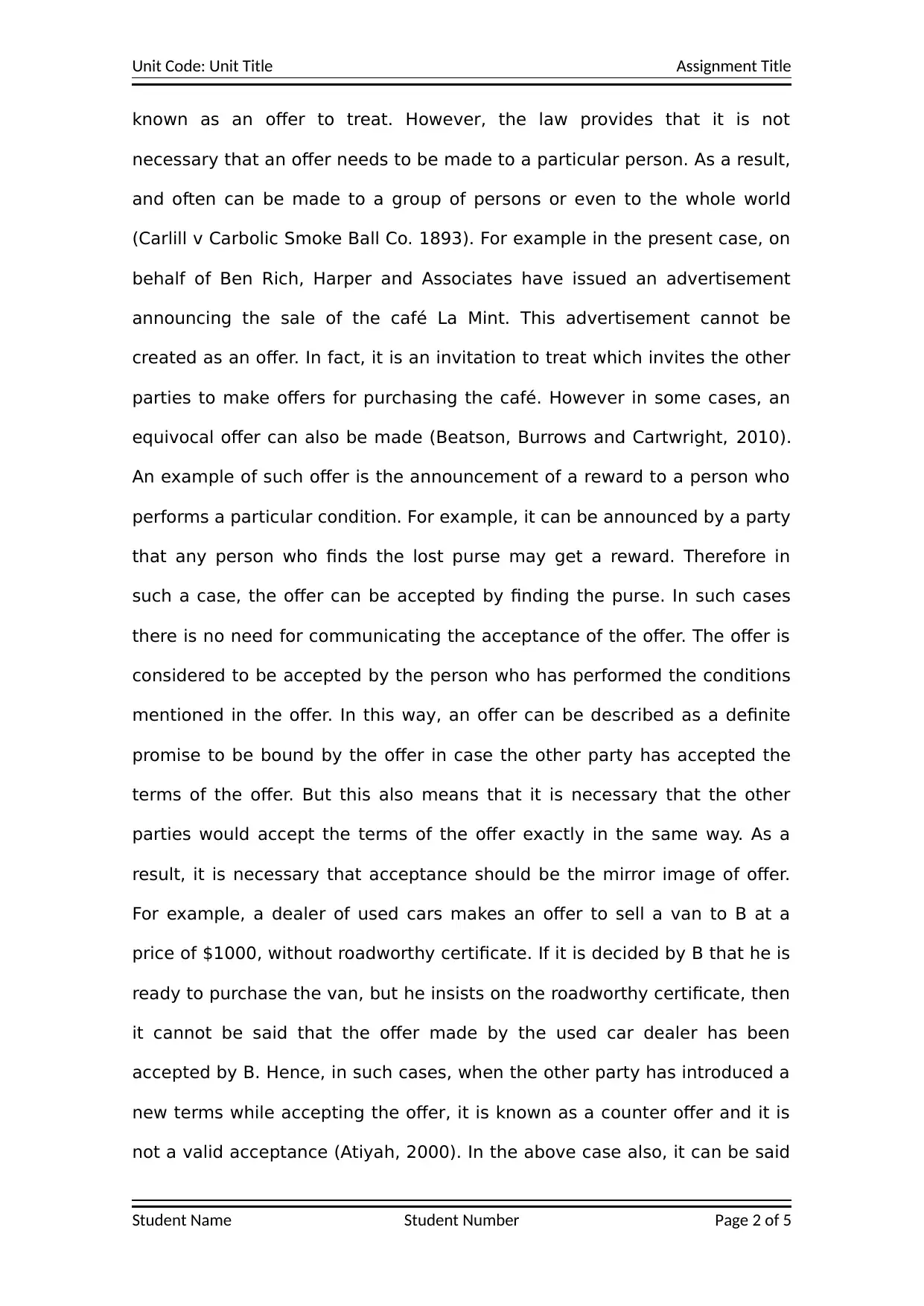
Unit Code: Unit Title Assignment Title
known as an offer to treat. However, the law provides that it is not
necessary that an offer needs to be made to a particular person. As a result,
and often can be made to a group of persons or even to the whole world
(Carlill v Carbolic Smoke Ball Co. 1893). For example in the present case, on
behalf of Ben Rich, Harper and Associates have issued an advertisement
announcing the sale of the café La Mint. This advertisement cannot be
created as an offer. In fact, it is an invitation to treat which invites the other
parties to make offers for purchasing the café. However in some cases, an
equivocal offer can also be made (Beatson, Burrows and Cartwright, 2010).
An example of such offer is the announcement of a reward to a person who
performs a particular condition. For example, it can be announced by a party
that any person who finds the lost purse may get a reward. Therefore in
such a case, the offer can be accepted by finding the purse. In such cases
there is no need for communicating the acceptance of the offer. The offer is
considered to be accepted by the person who has performed the conditions
mentioned in the offer. In this way, an offer can be described as a definite
promise to be bound by the offer in case the other party has accepted the
terms of the offer. But this also means that it is necessary that the other
parties would accept the terms of the offer exactly in the same way. As a
result, it is necessary that acceptance should be the mirror image of offer.
For example, a dealer of used cars makes an offer to sell a van to B at a
price of $1000, without roadworthy certificate. If it is decided by B that he is
ready to purchase the van, but he insists on the roadworthy certificate, then
it cannot be said that the offer made by the used car dealer has been
accepted by B. Hence, in such cases, when the other party has introduced a
new terms while accepting the offer, it is known as a counter offer and it is
not a valid acceptance (Atiyah, 2000). In the above case also, it can be said
Student Name Student Number Page 2 of 5
known as an offer to treat. However, the law provides that it is not
necessary that an offer needs to be made to a particular person. As a result,
and often can be made to a group of persons or even to the whole world
(Carlill v Carbolic Smoke Ball Co. 1893). For example in the present case, on
behalf of Ben Rich, Harper and Associates have issued an advertisement
announcing the sale of the café La Mint. This advertisement cannot be
created as an offer. In fact, it is an invitation to treat which invites the other
parties to make offers for purchasing the café. However in some cases, an
equivocal offer can also be made (Beatson, Burrows and Cartwright, 2010).
An example of such offer is the announcement of a reward to a person who
performs a particular condition. For example, it can be announced by a party
that any person who finds the lost purse may get a reward. Therefore in
such a case, the offer can be accepted by finding the purse. In such cases
there is no need for communicating the acceptance of the offer. The offer is
considered to be accepted by the person who has performed the conditions
mentioned in the offer. In this way, an offer can be described as a definite
promise to be bound by the offer in case the other party has accepted the
terms of the offer. But this also means that it is necessary that the other
parties would accept the terms of the offer exactly in the same way. As a
result, it is necessary that acceptance should be the mirror image of offer.
For example, a dealer of used cars makes an offer to sell a van to B at a
price of $1000, without roadworthy certificate. If it is decided by B that he is
ready to purchase the van, but he insists on the roadworthy certificate, then
it cannot be said that the offer made by the used car dealer has been
accepted by B. Hence, in such cases, when the other party has introduced a
new terms while accepting the offer, it is known as a counter offer and it is
not a valid acceptance (Atiyah, 2000). In the above case also, it can be said
Student Name Student Number Page 2 of 5
Paraphrase This Document
Need a fresh take? Get an instant paraphrase of this document with our AI Paraphraser
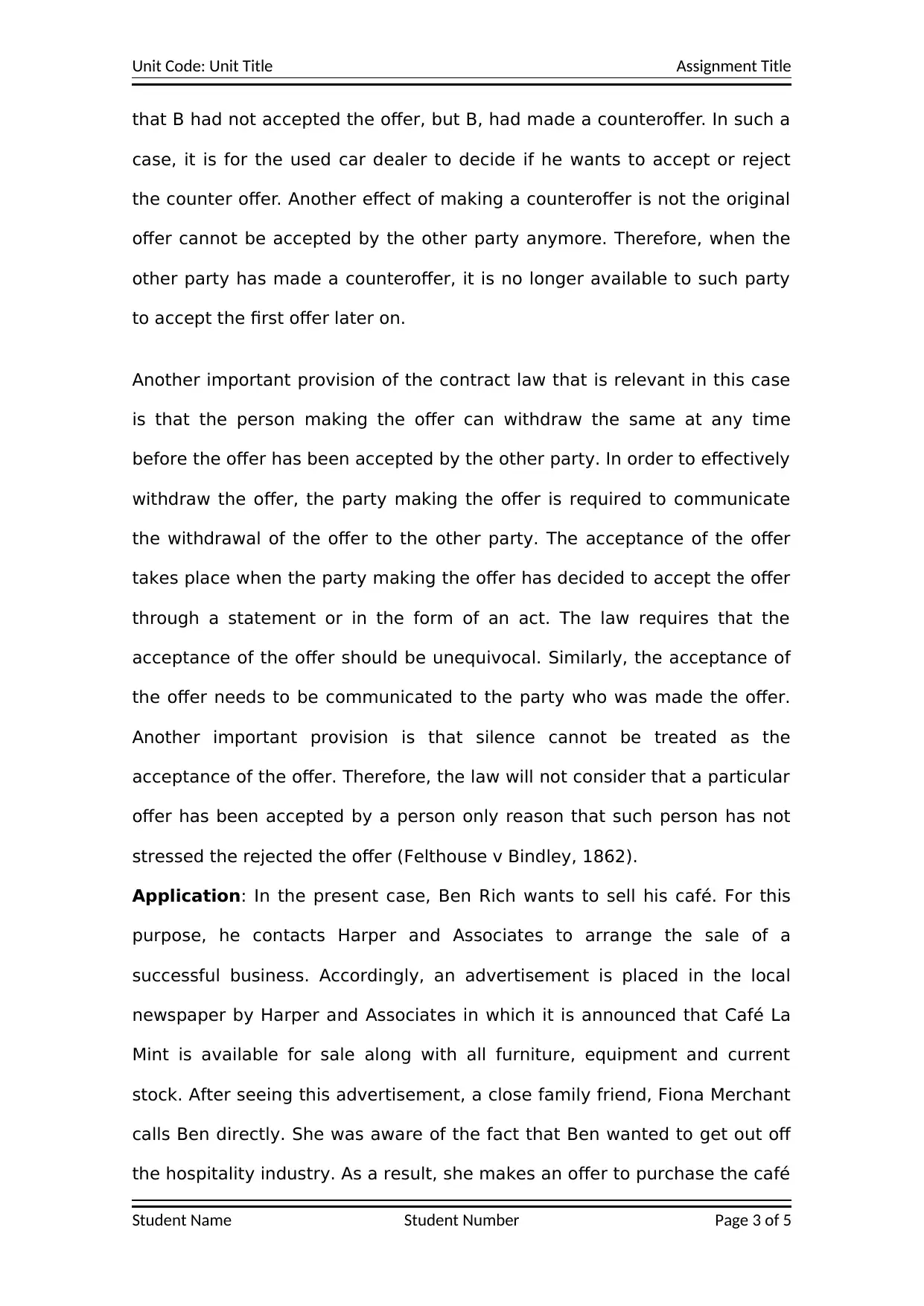
Unit Code: Unit Title Assignment Title
that B had not accepted the offer, but B, had made a counteroffer. In such a
case, it is for the used car dealer to decide if he wants to accept or reject
the counter offer. Another effect of making a counteroffer is not the original
offer cannot be accepted by the other party anymore. Therefore, when the
other party has made a counteroffer, it is no longer available to such party
to accept the first offer later on.
Another important provision of the contract law that is relevant in this case
is that the person making the offer can withdraw the same at any time
before the offer has been accepted by the other party. In order to effectively
withdraw the offer, the party making the offer is required to communicate
the withdrawal of the offer to the other party. The acceptance of the offer
takes place when the party making the offer has decided to accept the offer
through a statement or in the form of an act. The law requires that the
acceptance of the offer should be unequivocal. Similarly, the acceptance of
the offer needs to be communicated to the party who was made the offer.
Another important provision is that silence cannot be treated as the
acceptance of the offer. Therefore, the law will not consider that a particular
offer has been accepted by a person only reason that such person has not
stressed the rejected the offer (Felthouse v Bindley, 1862).
Application: In the present case, Ben Rich wants to sell his café. For this
purpose, he contacts Harper and Associates to arrange the sale of a
successful business. Accordingly, an advertisement is placed in the local
newspaper by Harper and Associates in which it is announced that Café La
Mint is available for sale along with all furniture, equipment and current
stock. After seeing this advertisement, a close family friend, Fiona Merchant
calls Ben directly. She was aware of the fact that Ben wanted to get out off
the hospitality industry. As a result, she makes an offer to purchase the café
Student Name Student Number Page 3 of 5
that B had not accepted the offer, but B, had made a counteroffer. In such a
case, it is for the used car dealer to decide if he wants to accept or reject
the counter offer. Another effect of making a counteroffer is not the original
offer cannot be accepted by the other party anymore. Therefore, when the
other party has made a counteroffer, it is no longer available to such party
to accept the first offer later on.
Another important provision of the contract law that is relevant in this case
is that the person making the offer can withdraw the same at any time
before the offer has been accepted by the other party. In order to effectively
withdraw the offer, the party making the offer is required to communicate
the withdrawal of the offer to the other party. The acceptance of the offer
takes place when the party making the offer has decided to accept the offer
through a statement or in the form of an act. The law requires that the
acceptance of the offer should be unequivocal. Similarly, the acceptance of
the offer needs to be communicated to the party who was made the offer.
Another important provision is that silence cannot be treated as the
acceptance of the offer. Therefore, the law will not consider that a particular
offer has been accepted by a person only reason that such person has not
stressed the rejected the offer (Felthouse v Bindley, 1862).
Application: In the present case, Ben Rich wants to sell his café. For this
purpose, he contacts Harper and Associates to arrange the sale of a
successful business. Accordingly, an advertisement is placed in the local
newspaper by Harper and Associates in which it is announced that Café La
Mint is available for sale along with all furniture, equipment and current
stock. After seeing this advertisement, a close family friend, Fiona Merchant
calls Ben directly. She was aware of the fact that Ben wanted to get out off
the hospitality industry. As a result, she makes an offer to purchase the café
Student Name Student Number Page 3 of 5
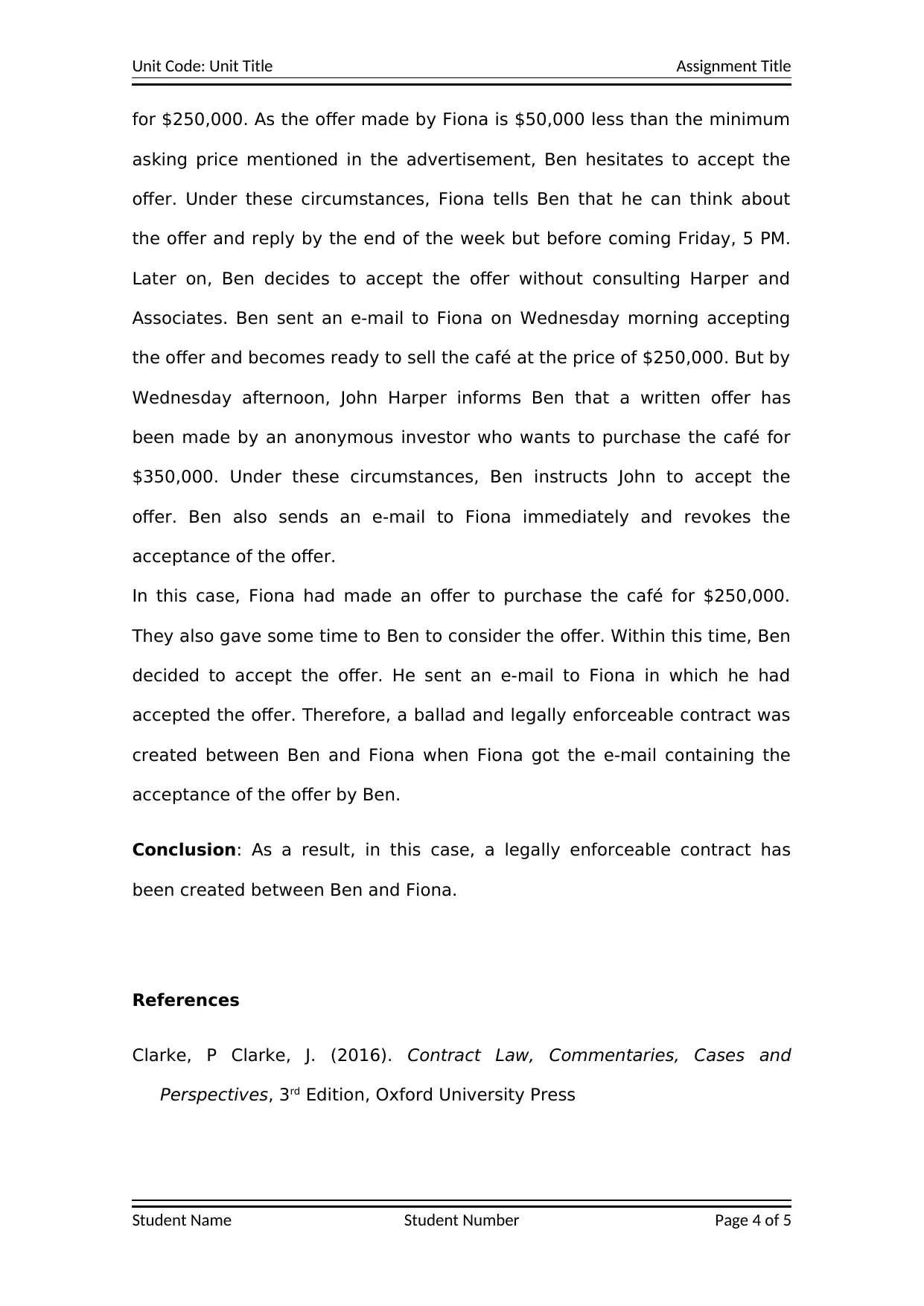
Unit Code: Unit Title Assignment Title
for $250,000. As the offer made by Fiona is $50,000 less than the minimum
asking price mentioned in the advertisement, Ben hesitates to accept the
offer. Under these circumstances, Fiona tells Ben that he can think about
the offer and reply by the end of the week but before coming Friday, 5 PM.
Later on, Ben decides to accept the offer without consulting Harper and
Associates. Ben sent an e-mail to Fiona on Wednesday morning accepting
the offer and becomes ready to sell the café at the price of $250,000. But by
Wednesday afternoon, John Harper informs Ben that a written offer has
been made by an anonymous investor who wants to purchase the café for
$350,000. Under these circumstances, Ben instructs John to accept the
offer. Ben also sends an e-mail to Fiona immediately and revokes the
acceptance of the offer.
In this case, Fiona had made an offer to purchase the café for $250,000.
They also gave some time to Ben to consider the offer. Within this time, Ben
decided to accept the offer. He sent an e-mail to Fiona in which he had
accepted the offer. Therefore, a ballad and legally enforceable contract was
created between Ben and Fiona when Fiona got the e-mail containing the
acceptance of the offer by Ben.
Conclusion: As a result, in this case, a legally enforceable contract has
been created between Ben and Fiona.
References
Clarke, P Clarke, J. (2016). Contract Law, Commentaries, Cases and
Perspectives, 3rd Edition, Oxford University Press
Student Name Student Number Page 4 of 5
for $250,000. As the offer made by Fiona is $50,000 less than the minimum
asking price mentioned in the advertisement, Ben hesitates to accept the
offer. Under these circumstances, Fiona tells Ben that he can think about
the offer and reply by the end of the week but before coming Friday, 5 PM.
Later on, Ben decides to accept the offer without consulting Harper and
Associates. Ben sent an e-mail to Fiona on Wednesday morning accepting
the offer and becomes ready to sell the café at the price of $250,000. But by
Wednesday afternoon, John Harper informs Ben that a written offer has
been made by an anonymous investor who wants to purchase the café for
$350,000. Under these circumstances, Ben instructs John to accept the
offer. Ben also sends an e-mail to Fiona immediately and revokes the
acceptance of the offer.
In this case, Fiona had made an offer to purchase the café for $250,000.
They also gave some time to Ben to consider the offer. Within this time, Ben
decided to accept the offer. He sent an e-mail to Fiona in which he had
accepted the offer. Therefore, a ballad and legally enforceable contract was
created between Ben and Fiona when Fiona got the e-mail containing the
acceptance of the offer by Ben.
Conclusion: As a result, in this case, a legally enforceable contract has
been created between Ben and Fiona.
References
Clarke, P Clarke, J. (2016). Contract Law, Commentaries, Cases and
Perspectives, 3rd Edition, Oxford University Press
Student Name Student Number Page 4 of 5
⊘ This is a preview!⊘
Do you want full access?
Subscribe today to unlock all pages.

Trusted by 1+ million students worldwide
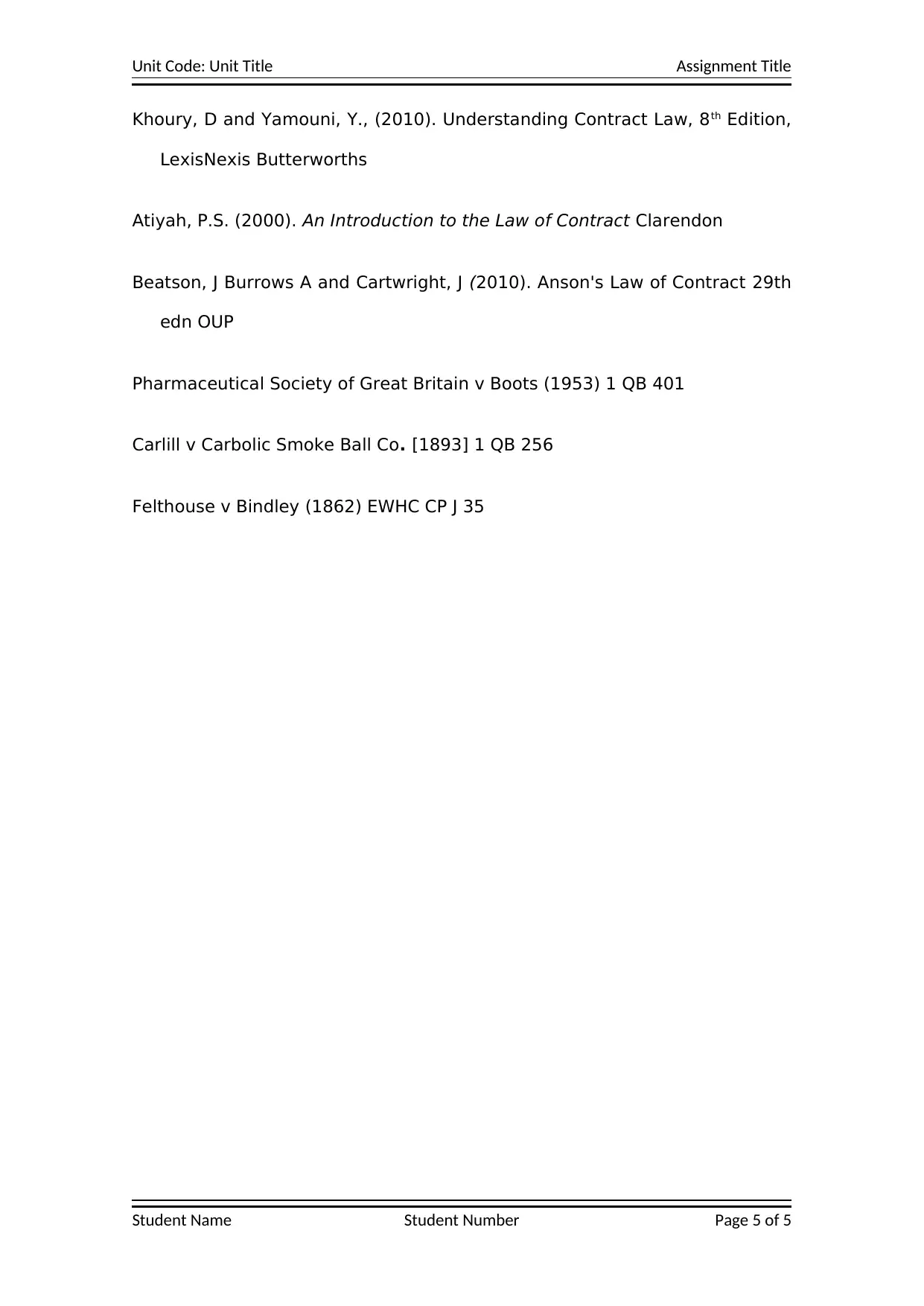
Unit Code: Unit Title Assignment Title
Khoury, D and Yamouni, Y., (2010). Understanding Contract Law, 8th Edition,
LexisNexis Butterworths
Atiyah, P.S. (2000). An Introduction to the Law of Contract Clarendon
Beatson, J Burrows A and Cartwright, J (2010). Anson's Law of Contract 29th
edn OUP
Pharmaceutical Society of Great Britain v Boots (1953) 1 QB 401
Carlill v Carbolic Smoke Ball Co. [1893] 1 QB 256
Felthouse v Bindley (1862) EWHC CP J 35
Student Name Student Number Page 5 of 5
Khoury, D and Yamouni, Y., (2010). Understanding Contract Law, 8th Edition,
LexisNexis Butterworths
Atiyah, P.S. (2000). An Introduction to the Law of Contract Clarendon
Beatson, J Burrows A and Cartwright, J (2010). Anson's Law of Contract 29th
edn OUP
Pharmaceutical Society of Great Britain v Boots (1953) 1 QB 401
Carlill v Carbolic Smoke Ball Co. [1893] 1 QB 256
Felthouse v Bindley (1862) EWHC CP J 35
Student Name Student Number Page 5 of 5
1 out of 7
Related Documents
Your All-in-One AI-Powered Toolkit for Academic Success.
+13062052269
info@desklib.com
Available 24*7 on WhatsApp / Email
![[object Object]](/_next/static/media/star-bottom.7253800d.svg)
Unlock your academic potential
Copyright © 2020–2025 A2Z Services. All Rights Reserved. Developed and managed by ZUCOL.





